A durable, leak-free CPVC pipe installation requires careful attention to detail, especially when applying CPVC glue (solvent cement).
What is CPVC? Chlorinated polyvinyl chloride is a thermoplastic known for its high temperature and chemical resistance, making it ideal for hot-water supply systems, fire sprinklers, and industrial applications. However, improper solvent cementing can lead to joint failures and costly repairs.
This guide will explore the most frequent errors plumbers and other installers make when working with CPVC pipes and provide essential tips to ensure every installation is secure and long-lasting.
Why Proper Solvent Cementing Matters
Before we dive into common mistakes, it’s important to understand why following the correct procedure is vital. Unlike adhesives, solvent cement doesn’t “glue” CPVC pipes together. Instead, it softens the surfaces of the pipe and fitting, chemically fusing them. The result? A strong, watertight bond.
However, even minor missteps—using the wrong cement or skipping essential preparation steps—can jeopardize the bond, leading to leaks, weak joints, or system failures down the line.
CPVC vs. PVC: Using the Right Solvent Cement
A common mistake is assuming that CPVC vs. PVC pipes use the same solvent cement. CPVC pipes require a cement specifically formulated for its unique chemical makeup. Using PVC cement on CPVC won’t create a proper chemical bond, which can lead to leaks or pipe failures over time. Always check the label for compatibility to avoid costly mistakes.
Need help choosing the right cement? Our blog, How to Choose the Right Solvent Cement, offers expert guidance.
Common CPVC Solvent Cement Mistakes and How to Avoid Them
1. Using the Wrong Solvent Cement
As mentioned above, CPVC and PVC cements are not interchangeable. Using the wrong solvent cement prevents proper chemical bonding.
- Solution: Use a CPVC-specific cement such as Oatey FlowGuard Gold Cement for potable water systems or Oatey Orange Lava CPVC Cement for quick repairs.

2. Skipping Primer on Non-One-Step Solvent Cements
Priming is critical because it ensures the surfaces are clean and pre-softened for an effective bond. Yet many professionals skip this step, especially when rushing a job.
However, note that some CPVC cements, such as Oatey FlowGuard Gold Cement, are “one-step” and don’t require a separate primer. Always verify the cement type before application.
- Solution: Use Oatey Primer before applying cement—unless you are using a one-step CPVC glue like FlowGuard Gold Cement, which doesn’t require priming.

3. Failing to Prepare Pipe Surfaces
Dirty or rough CPVC pipe surfaces can prevent proper bonding.
- Solution:
- Clean the pipe and fitting with a dry cloth.
- Chamfer and deburr the edges for a smooth, secure fit.
- Confirm a snug, smooth fit during a dry run.
4. Dry-Fitting Without Cementing
Dry-fitting without the final application of solvent cement is common for quick measurements. However, forgetting to return and cement the joint can lead to catastrophic system failures. Worse, dry-fitted joints might initially pass pressure tests, only to fail later due to changes like water hammering.
- Solution:
- Always double-check every joint before completing the system.
- Use visual indicators, such as Oatey’s FlowGuard High Contrast Cement, which provides a dark green color that stands out, even on poorly lit job sites.

5. Applying Too Much or Too Little Solvent Cement
Using too little cement prevents proper bonding. Excessive cement can create puddles inside the pipe, weakening the joint or blocking the flow.
- Solution:
- Apply an even layer of cement using an appropriate-sized applicator like the Oatey Adjustable Dauber.
- Be sure to cover both the pipe and fitting evenly, avoiding excess buildup inside the joint.
- For step-by-step guidance, check out our project guide, How to Easily Connect Pipes Using Solvent Cement.
6. Rushing the Curing Process
Curing allows the solvents in the cement to evaporate entirely, forming a strong and reliable bond. For CPVC, curing typically takes double the time of PVC, making it vital to get it right. Rushing this process will lead to weak joints and potential failures.
- Solution:
- Follow cure time guidelines based on pipe size, temperature, and humidity. For example:
- Smaller pipes (up to 2 inches) may cure faster than larger pipes.
- High humidity or colder temperatures require longer curing times.
- Ensure proper ventilation to aid solvent evaporation.
- Follow cure time guidelines based on pipe size, temperature, and humidity. For example:
7. Poor Ventilation or Sealing Too Soon
When sealing a system too quickly, trapped solvents can soften or weaken the joint, sometimes creating cracks or holes during future use.
- Solution:
- Ensure adequate ventilation by leaving one pipe end open during curing.
- For larger systems, consider using ventilation tools, such as fans, to circulate air around the piping.
8. Ignoring Environmental Factors
Extreme temperatures and high humidity can negatively impact cure times and solvent effectiveness.
- Solution:
- Store solvent cement between 40°F and 110°F to avoid freezing or becoming too viscous.
- Adjust application practices based on job-site conditions. For humid areas, allow extra curing time to compensate for slower evaporation.
Ensure Stronger, Leak-Free CPVC Systems
Avoiding common mistakes and using proper techniques can significantly reduce the risk of joint failures and ensure a durable CPVC installation. Proper preparation, the right products, and patience during curing all contribute to successful solvent cement application.
For high-quality CPVC solvent cement and primers, explore Oatey’s full range of trusted products here.